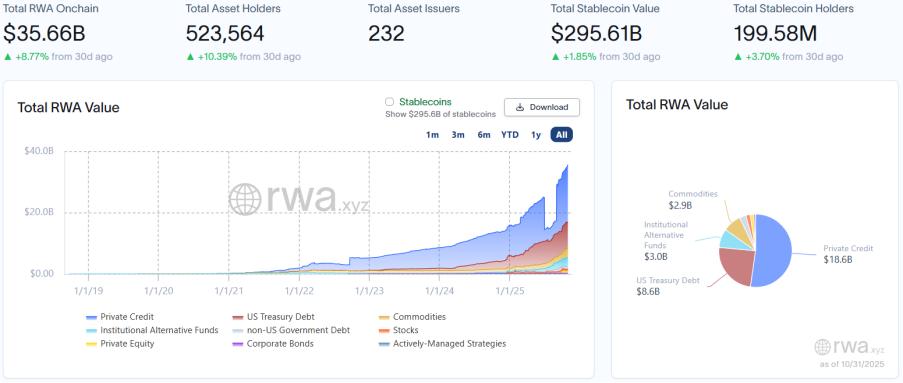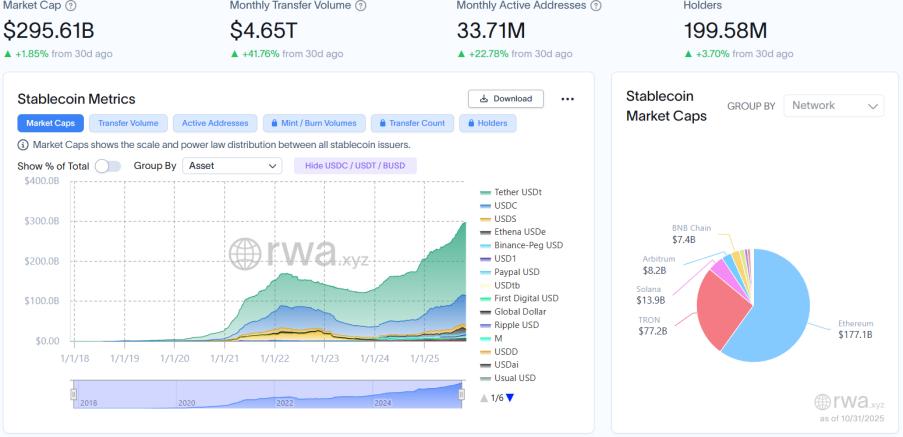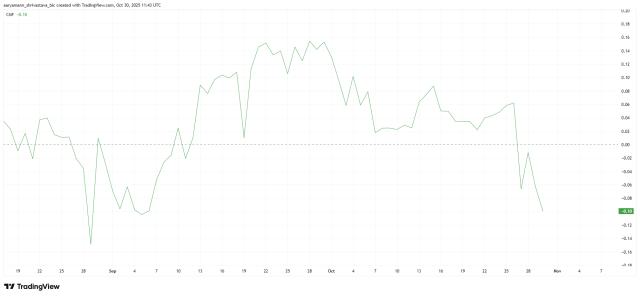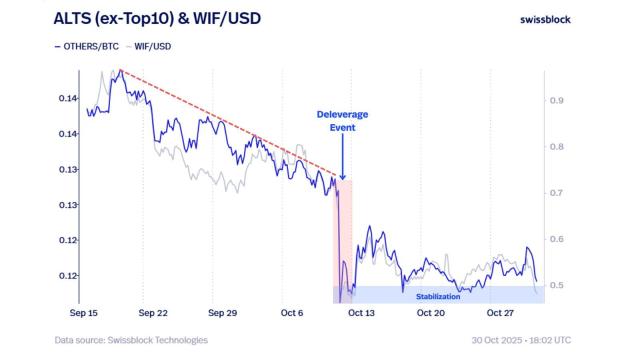Highlights of this episode
This week's weekly report covers the period from October 24th to October 30th, 2025. The RWA market continued its steady growth this week, with a total on-chain market capitalization of $35.66 billion, an 8.77% increase week-over-week. The number of holders exceeded 520,000, indicating a continuously expanding user base. Stablecoin transaction volume surged to $4.65 trillion, with monthly active addresses also rebounding, indicating the market has entered a healthy expansion cycle driven by efficiency, with significantly improved capital turnover efficiency. On the regulatory front, Canada and South Korea accelerated the legislative process for stablecoin regulation, while Europe's pace was slightly slower. The Hong Kong Monetary Authority stated its intention to build a digital currency framework to promote the complementary coexistence of various tokenized currencies. At the project level, tokenization platforms Securitize and tZero launched their IPO plans, impacting traditional capital markets; JPMorgan Chase completed the tokenization of its private equity fund on its self-developed blockchain and plans to launch an investment fund tokenization platform; Circle's payment public chain Arc launched its public beta, with traditional giants actively participating.
Data Perspective
RWA Track Panorama
According to the latest data disclosed by RWA.xyz, as of October 31, 2025, the total market capitalization of RWA on-chain reached US$35.66 billion, an increase of 8.77% compared to the same period last month, although the growth rate has slowed down; the total number of asset holders exceeded 523,600, an increase of 10.39% compared to the same period last month, indicating a continued increase in market participation; and the total number of asset issuers rose to 232.

Stablecoin Market
The total market capitalization of stablecoins reached $295.61 billion, a 1.85% increase month-over-month, achieving moderate growth. Monthly transaction volume surged to $4.65 trillion, a significant 41.76% increase month-over-month. The total number of monthly active addresses rebounded to 33.71 million, a 22.78% increase month-over-month. The total number of holders was approximately 200 million, a slight 3.70% increase month-over-month. Both figures confirm that the market has entered a healthy expansion cycle driven by efficiency, with the efficiency of existing capital turnover and user activity improving simultaneously, creating a virtuous cycle. Data shows that institutional settlement demand and the return of retail transactions have combined to create explosive growth in transaction volume, far exceeding the growth rate of market capitalization, highlighting the strengthening of on-chain payment and settlement functions. The leading stablecoins are USDT, USDC, and USDe. Among them, USDT's market capitalization increased by 3.82% month-over-month; USDC's market capitalization increased slightly by 1.84% month-over-month; and USDe's market capitalization further deteriorated, declining sharply by 31.21% month-over-month.

Regulatory news
According to sources familiar with the matter, Canada is in discussions regarding stablecoin regulatory rules and may announce a major update in the federal budget to be released next week. These sources indicate that government officials have been engaged in in-depth discussions with regulators and industry players for weeks. It is reported that Canadian Finance Minister François-Philippe Champagne will address this issue in the budget document to be released on November 4th. In July, the United States passed the Genius Act, authorizing financial regulators to oversee stablecoin issuers and their reserve management, and requiring issuers to comply with anti-money laundering and sanctions evasion regulations. This new law has been welcomed by many in the crypto industry. However, in Canada, due to a lack of relevant legislation, regulators have stated that stablecoins may constitute securities or derivatives. Some experts argue that they should be regulated as payment instruments and subject to strict oversight.
According to Yonhap News Agency, Park Sung-hoon, a lawmaker from the People Power Party, will lead a bill to amend the Foreign Exchange Transactions Act, proposing to formally include stablecoins within the scope of legally recognized means of payment. This move aims to fill regulatory gaps in current laws and fundamentally prevent the use of stablecoins for money laundering, tax evasion, and other illegal activities. The amendment explicitly adds stablecoins as a means of payment in Article 3, Section 1, "Definitions," meaning that stablecoins will gain the same legal status as traditional payment instruments such as South Korean government banknotes, banknotes, and coins. This legislative move echoes concerns raised by the Bank of Korea. In a recent written submission to the National Assembly, the Bank of Korea expressed concern about the potential risks of dollar-denominated stablecoins, pointing out that they "may bypass the reporting procedures stipulated in the Foreign Exchange Transactions Act and be used for current account and capital account transactions between countries."
In an article titled "Paving the Way for Hong Kong's Digital Economy" published in *The Hong Kong Monetary Authority*, Chief Executive Eddie Yue announced the release of a blueprint for the next phase of fintech development to ensure Hong Kong remains at the forefront of fintech. The Hong Kong Monetary Authority will explore central bank digital currencies (CBDCs) and build next-generation data infrastructure, further studying tokenization to improve the financial system. Furthermore, Hong Kong will establish a comprehensive digital currency framework to promote the complementary coexistence of different forms of tokenized currencies, including digital Hong Kong dollars, tokenized deposits, and regulated stablecoins.
The European Central Bank hopes to launch a pilot program for a digital euro in 2027.
The European Central Bank (ECB) said on Thursday it could launch its digital currency pilot program in 2027, should it receive timely approval from lawmakers. The ECB considers the project crucial to the eurozone's financial autonomy, viewing it as a strategic alternative to US-dominated private payment methods such as credit cards and stablecoins. The ECB stated that this move is increasingly important in an era of heightened geopolitical tensions, as financial autonomy and resilience are seen as key to maintaining European economic sovereignty. After four years of research and preparation, the ECB said it is currently considering a pilot program, meaning some digital euro transactions could begin as early as mid-2027, with a full rollout two years later.
Local News
According to Caixin, Bank of China (Hong Kong) announced a partnership with convenience store chain Circle K and vending machine operator FreshUp. Starting October 27, 2025, over 380 Circle K stores and the first batch of 1,200 FreshUp vending machines across Hong Kong will officially support digital yuan (e-CNY) payments. Hong Kong residents and mainland visitors can use BoC Pay+'s "Digital Yuan Zone" or the "Digital Yuan" App to make e-CNY payments at these convenience stores and vending machines. Bank of China (Hong Kong) has upgraded the acquiring systems of Circle K and FreshUp and will automatically convert digital yuan into Hong Kong dollars to assist merchants with cross-border clearing.
Project progress
Custodia and Vantage Bank launch a real-time tokenized deposit network for US banks.
According to Decrypt, Custodia Bank and Vantage Bank Texas have launched a live network for tokenized deposits to US banks, expanding their previous pilot program to a nationwide network of US banks. The system supports switching between deposits and GENIUS-compliant stablecoins. The platform is awaiting final regulatory approval before large-scale launch.
According to Financefeeds, Swiss cryptocurrency bank AMINA Bank has partnered with Luxembourg-based tokenization company Tokeny to provide a regulated channel for digital securities issuance. This collaboration connects AMINA's bank-grade custody and settlement with Tokeny's ERC-3643-based issuance stack. The goal is to create a single platform that handles both primary issuance and qualified custody simultaneously. The bank holds investor funds and oversees accounts within the framework of the Swiss Financial Market Supervisory Authority (FINMA), while smart contracts execute eligibility checks and transfer rules on-chain. The two companies stated that by eliminating custom integrations and reducing manual checks, this can reduce time to market for institutional issuers from months to weeks.
tZero, a tokenized securities market platform, is preparing for its 2026 IPO.
tZero Group Inc., which operates a securities market linked to digital tokens, plans to IPO in 2026, according to its CEO, Alan Konevsky. Investors include the Intercontinental Exchange (ICE). Konevsky said the company has been in talks with bankers about the IPO but has not yet selected a partner. He added that the company is also exploring pre-IPO financing. The company, which has more than 50 employees, is not yet profitable.
Circle launches Arc blockchain public testnet, with Visa and BlackRock among the participants.
According to CoinDesk, Circle (the issuer of USDC, CRCL) has launched a public beta test of its payment-oriented Arc blockchain, with over 100 institutions participating, including Visa, HSBC, BlackRock, AWS, Anthropic, Coinbase, and Kraken. Arc is positioned as a foundational layer for financial services, offering USD billing, sub-second settlement, optional privacy, and integration with the Circle payment system. Visa is testing stablecoin settlements to accelerate cross-border payments, while BlackRock is exploring stablecoin settlements and on-chain FX. Circle states its long-term goal is decentralization, with open validators and governance.
Asset tokenization company Securitize will go public through a $1.25 billion SPAC deal.
According to The Block, Securitize becomes the latest crypto-native company to announce plans for an IPO, with a pre-IPO equity valuation of $1.25 billion. The asset tokenization giant plans to list in the US through a special purpose acquisition company (SPAC) launched by an affiliate of Cantor Fitzgerald. The merged company will be renamed Securitize Corp. and will trade on Nasdaq under the ticker symbol SECZ. The company also plans to tokenize its own equity.
The company stated that, as part of its public offering process, Securitize also plans to raise a total of $469 million in proceeds to “strengthen the company’s balance sheet” and accelerate its business roadmap. This funding comes partly from a fully committed $225 million private equity investment public offering (PIPE) that attracted new investors including Arche, Borderless Capital, Hanwha Investment & Securities, InterVest, and ParaFi Capital. Citigroup and Cantor will act as joint placement agents for the PIPE transaction. Securitize announced that existing shareholders, including ARK Invest, BlackRock, Blockchain Capital, Hamilton Lane, Jump Crypto, and Morgan Stanley Investment Management, will transfer 100% of their equity to the merged company.
Decentralized finance protocol Grove announced in its official blog the launch of the Securitize Tokenized AAA-rated CLO Fund (STAC), focusing on tokenized investments in AAA-rated CLO tranches. The fund is custodied by Bank of New York Mellon (BNY) and advised by its investment arm, Insight. Subject to governance approval, Grove will provide a $100 million pegged investment to STAC. Fund units will be issued in Ethereum digital tokens, and eligible investors can subscribe through the Securitize platform.
Ondo expands its tokenized products to BNB Chain
According to Cointelegraph, RWA tokenization platform Ondo Global Markets has expanded its tokenized offerings to BNB Chain, enabling BNB Chain users to trade over 100 Wall Street stocks and ETFs. Ondo stated in a press release on Wednesday: “This integration gives BNB Chain access to over 100 tokenized U.S. stocks and ETFs, and is supported by ecosystem projects such as PancakeSwap.”
According to The Wall Street Journal, JPMorgan Chase has completed a pilot tokenization of a private equity fund on its proprietary blockchain network. The project aims to enable on-chain representation and settlement of fund units to improve liquidity and transparency. JPMorgan Chase stated that it plans to officially launch its "Alternative Investment Fund Tokenization Platform" in 2026, providing institutional clients with on-chain issuance and trading services for private equity, credit, and other non-public market assets.
Japanese startup JPYC will launch the first stablecoin pegged to the Japanese yen.
The world's first stablecoin pegged to the Japanese yen will launch in Japan on Monday, Reuters reported. A Japanese startup, JPYC, announced it will begin issuing a stablecoin fully convertible to yen and backed by domestic savings and Japanese government bonds (JGBs). Initially, JPYC will not charge transaction fees, focusing instead on expanding its use, and will instead earn returns through interest earned from holding Japanese government bonds.
According to CoinDesk, TIS, a Japanese payment infrastructure provider with an annual transaction volume of $2 trillion, has partnered with the Avalanche team to launch a multi-token platform based on AvaCloud, supporting the issuance and settlement of stablecoins, tokenized deposits, and future central bank digital currencies (CBDCs). The platform complies with Japan's Payment Services Act and aims to promote the transformation of financial infrastructure towards programmability and real-time settlement. TIS will collaborate with banks, businesses, and government agencies to promote the global adoption of the system.
According to official sources, MSX has completed spot and contract trading for communications and optical network provider NOK.M and clean energy company NEE.M. Spot trading for integrated power company VST.M has also been added simultaneously.
Insights Highlights
According to The Block, Standard Chartered Bank estimates that the market capitalization of Real-World Asset Tokenization (RWA), excluding stablecoins, is projected to expand from approximately $35 billion to $2 trillion by 2028, representing a growth of about 5600%. Geoffrey Kendrick, Head of Digital Asset Research at Standard Chartered, stated that stablecoins lay the foundation for the large-scale on-chaining of other assets, with the "vast majority" of such activity taking place on Ethereum, given its over 10 years of operation without mainnet outages. Kendrick estimates that by 2028, tokenized money market funds and listed stocks will account for the largest share, with money market funds, driven by corporate use of stablecoins, accounting for $750 billion, and listed stocks, pending clarification of US regulations, also accounting for $750 billion. Kendrick believes that lending, especially RWA, is key to DeFi's disruption of traditional finance, and that DeFi has begun a growth cycle. The US Genius Act has accelerated the adoption of stablecoins, and the Digital Asset Markets Clarification Act is expected to further legalize asset tokenization. Even without this act, regulatory bodies may have clear rules operating within the law; however, the lack of clarity in US regulations remains a risk.
PANews Overview: This article outlines Mastercard's plan to acquire stablecoin infrastructure company Zerohash for between $15 billion and $20 billion, a move that strongly signals traditional financial giants' deep embrace of blockchain technology and their integration of stablecoins into their core payment systems. This is not an isolated case; Stripe previously acquired a similar company, Bridge, indicating a bidding war within the traditional payments industry for stablecoin and blockchain infrastructure companies. Unlike competitors focused on payment applications, Zerohash offers a broader range of technology products, including APIs to help financial institutions build cryptocurrency trading platforms and tokenize traditional assets. Therefore, Mastercard's potential acquisition is seen as a key strategic move to seize control of the future pillar of global payments—blockchain infrastructure—marking a full-scale shift in the "payments war" towards blockchain.
PANews Overview: The core argument of this article is that traditional financial assets, represented by US Treasury bonds and stocks, are being massively "tokenized" and moved onto the blockchain. This marks a crucial turning point where "real-world asset tokenization" has moved from a conceptual experiment to acceptance by mainstream financial institutions. Its development path is clear: first, assets that generate stable cash flows, such as Treasury bonds and private loans, are tokenized to build a reliable "yield base"; then, based on this, equity assets such as US stocks and ETFs are also converted into tokens through blockchain technology, enabling near-24/7 trading for global investors. The core value of this transformation lies in its combination of blockchain efficiency (such as 24/7 trading and rapid settlement) with the compliance framework of traditional finance (such as KYC verification and asset custody). Platforms like Ondo Finance, through compliant product structures and technical solutions, have successfully attracted institutional investors, thereby reshaping Wall Street's asset distribution model and creating a more efficient and transparent new infrastructure for global capital allocation.
RWA in the Real World: Ondo Finance's On-Chain Bond Experiment and Institutional Innovation
PANews Overview: This article delves into the latest developments in "real-world asset on-chaining," particularly the successful practices of companies like Ondo Finance in transforming low-risk, interest-bearing traditional financial assets such as US Treasury bonds into on-chain tokens. Ondo invests funds in assets like short-term US Treasury bonds and issues tokens like OUGG and USDY, allowing investors—from qualified institutions to global retail users—to securely and transparently obtain stable returns on the blockchain. The key to this model's success lies in its clever combination of a compliant legal structure, a reliable technical architecture (such as cross-chain circulation and net asset value oracles), and strict risk controls (such as asset segregation and tiered redemption mechanisms), thereby gaining the trust of institutional investors. This signifies that blockchain is evolving from a simple accounting tool into a new generation of infrastructure capable of supporting mainstream financial assets.







